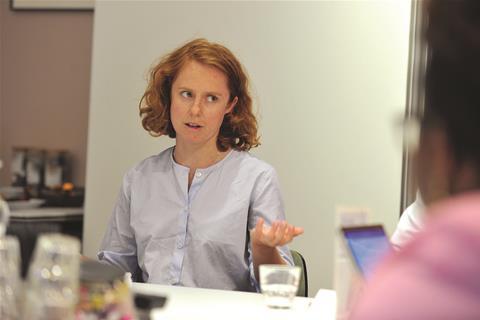Convincing clients to use digital technology and implementing new ways of working can be complex. Debika Ray reports on a roundtable by Bluebeam discussing the best ways to digitalise

At a roundtable event in London in July, 11 industry experts met for a roundtable sponsored by Bluebeam to examine the business impact of going digital. The event, with Building’s group technical editor Thomas Lane, discussed the best practices for maximising the impact of digital transformation on the bottom line, its implications for the supply chain and the scope for improving sustainability, collaboration and risk management through new tools and ways of working.
Almost immediately, talk turned to the role of the client in facilitating change, with Paul Beaty-Pownall, managing director at BPR Architects, arguing that this was the key to making progress.
“We haven’t quite got to the point where clients understand the benefits of digital construction – until there are benefits for the facilities management team, it won’t properly influence the design and build stages,” he said.
Trying to get clients on board is hard not because they’re not interested, but because they can’t see how it fits into their business model
Paul Beaty-Pownall, BPR Architects

Malcolm Taylor, independent specialist in programme and project information management, observed that a recent McKinsey report had put construction only above the agriculture sector when it came to digital transformation. “It’s pretty poor,” he said. “Clients could be instrumental in changing that because they ultimately control the money.”
Building’s Thomas Lane provided a slightly different perspective on the subject, pointing out that one-off clients could not be expected to drive forward industry change – and that it was the responsibility of construction companies to lead on this.
Nick Wheatley, design operations manager at Prater, responded that many smaller construction firms were also not in a strong enough financial position to make the changes required. Indeed, as Paul Jeffries, computational design lead at Ramboll, pointed out, in an industry with such low margins, there is not much money to invest in digital transformation. In that context, he added, it is incumbent on construction companies to focus on persuading clients by focusing on their needs.
We need to stop talking so much about the technology and more about what it can actually do
Paul Jeffries, Ramboll
‘Use concrete evidence’
“We hear a lot about BIM, AI and blockchain but clients don’t care about buzzwords – they care about the problem they want to solve. We need to stop talking so much about the technology and more about what it can actually do,” Jeffries said.
It was agreed that the industry needed to work harder to present the benefits of digital transformation, using concrete evidence to make the case.
Beaty-Pownall said: “In my experience, trying to get clients on board is hard not because they’re not interested, but because they can’t see how it fits into their business model.”
Dan Hoogeveen, digital design manager, Purcell, rebutted suggestions that the construction industry was bad at sharing information, claiming it was getting better, as systems that demand this skill, such as BIM, become more commonplace. “But we’re not particularly good as an industry at selling to the client what the benefits of, for example, having a digital twin is all about. It’s about bringing the client into the project team and helping them to visualise the end product and where they will get added value – there’s not enough of that going on.”
Taylor pointed out that the adoption of solutions such as creating a digital twin is primarily driven by money. “It’s evidently cheaper overall to run your facilities if you have a digital twin because you’re using predictive risk-based maintenance.” He suggested that construction firms could be looking to design facilities management systems as well as buildings as part of their brief, so they can ensure these benefits are realised.
You’re free to think about new ways of doing things when a lot of the administrative burden gets taken away by digital tools
Nelly Twumasi-Mensah, Faithful+Gould

Lower carbon
As a private sector industry, it was observed that the construction sector often makes profit and other financial benefits the central focus, but there are other, less talked about upsides to digital transformation. Beaty-Pownall provided a reminder that digital transformation was supposed to be about more than money.
“I think we’ve completely forgotten the vision behind the BIM mandate, which was to save energy and carbon over the building’s lifetime. If we’re now moving to a point when we’re expecting zero-carbon buildings, we should be using this technology to focus on a new vision we can all get around,” he said.
Jami Cresser-Brown, director at Bryden Wood, made a related point – that the focus needs to be on quality and not cost. “We shouldn’t just see digital technology is enabling us to work faster – what we should really be trying to do is see how it can enable us to work smarter, and deliver better solutions,” she said.
She added, however, that current business models did not support this – and that clients needed to stop believing that their money was simply buying hours of work. “Designers get paid based on effort and not based on value-add, so innovation isn’t so incentivised. We need to change this to incentivise people to come up with solutions.”
What incentivises you to share a digital twin with a subcontractor, supplier or facilities management?
James Chambers, Bluebeam
‘Fixing problems now’
Nelly Twumasi-Mensah, business change lead at Faithful+Gould, agreed on the importance of defining the reasons for change, as well as what they will mean: “Even before we start defining why, we absolutely have to understand, are you trying to change your business model? Are you trying to be more efficient? Are you trying to have differentiated service? We have to do a job of trying to explain what digital transformation actually means.”
From her perspective, digital transformation was simply another term for business transformation, enabled by digital tools – but she suggested that many people, from clients to consultants, did not understand that.
“As a consultant, being able to use these tools frees you up to add more value, as you’re free to think about new ways of doing things when a lot of the administrative burden gets taken away by digital tools,” she said. “The benefits are there but the language that we use to talk digital transformation needs to change – we need to start talking about digitally enabled business transformation. And we need to start explaining to the entire industry that digital transformation in the construction industry is not just about the future – it’s about fixing problems now. And if we fix the problems now, if the future starts to make sense.”
She added that people needed to change the way they work to make these changes feasible. “As soon as you introduce technology, people want to use technology in the same way that they worked in the non-technological way,” she said.
“People think they don’t need to change the way they work and that a new tool is going to fix everything, because they don’t like changing, but you have got to change the way you work or you won’t actually be able to realise any benefits from digital tools. What I’d like to do is give everyone a real insight into what this industry will look like in 15 years’ time, because then why we need to change will be clear.”
Partly, it was suggested that this was part of a wider failure of communication across the board. As Babak Tizkar, head of BIM and associate director at Atkins, said, digital tools are fundamentally supposed to help with communication but that is not happening. “And it’s getting worse because of digitised processes,” he said, referring to how people have a tendancy now to communicate digitally as a default rather than in person. Prater’s Wheatley agreed: “What makes BIM work is a collaborative approach.”
As an example of how sharing and openness can have benefits, Bryden Wood’s Cresser-Brown pointed to Prism, a free, open source design app the firm has developed to assist modular housebuilding in London. “We felt passionately that some of the barriers to [modular construction] were lack of knowledge of specific manufacturing systems,” she said. ‘We consulted all the manufacturers then shared the knowledge with the entire architecture community, because that’s the way to change the industry.”
James Chambers, UKI region director at Bluebeam, pointed out that this was the direction the industry was going in – that eventually companies would not compete over the technology they offer, but over the service they provide. “But there’s a lot of grey area over ownership of data. What incentivises you to share a digital twin with a subcontractor, supplier or facilities management?” he asked.
Several speakers mentioned industries such as manufacturing and automotive as examples of how digital transformation can be a success. But Beaty-Pownall pointed out the problem of construction’s complex nature as compared to other, more controlled sectors.
“Currently, the industry is so fragmented – the ownership of the land, the building, the management of that building, and a supply chain of small suppliers and contractors who are procured in a very adversarial way. Then you want to apply BIM on top of all that?” He advised a sector by sector approach, dealing with the specific challenges of each – commercial construction, public sector, transport infrastructure and so on. “You are talking about a completely different set of processes that go behind each, as well as different stakeholders involved, the amount of investment that they can put in and the revenue they can stand to make by doing it.
In light of that complexity, Todd Wynne, VP of strategy and partnerships at Bluebeam, sounded a positive note. “We put too much pressure on ourselves in the industry, saying we’re so slow to change. The iPad only came out 2010, and we’re already a deskless industry. We’re in the first eight years of what could be a 30-year digital transformation.”

Round the table:
- Chair: Thomas Lane, group technical editor, Building
- Adam McCall, business advisory and digital transformation, Arcadis
- Malcolm Taylor, independent specialist in programme and project information management
- Paul Beaty-Pownall, managing director, BPR architects
- Paul Jeffries, computational design specialist, Ramboll
- Nick Wheatley, design operations manager, Prater
- Babak Tizkar, head of BIM, associate director, Atkins
- Nelly Twumasi-Mensah, business change lead, Faithful+Gould
- Jami Cresser-Brown, director, Bryden Wood
- Dan Hoogeveen, digital design manager, Purcell
- James Chambers, UKI region director, Bluebeam
- Todd Wynne, vice president strategy and partnerships, Bluebeam
































No comments yet